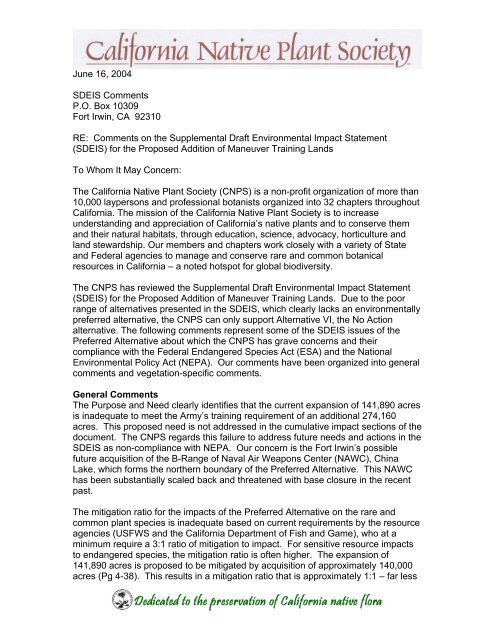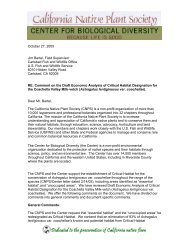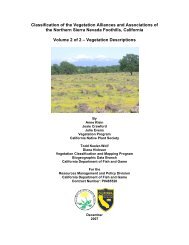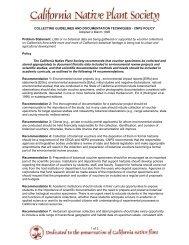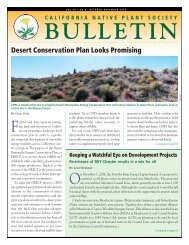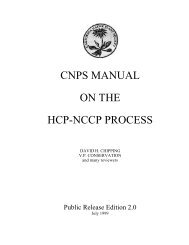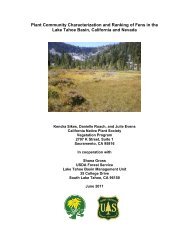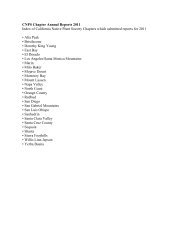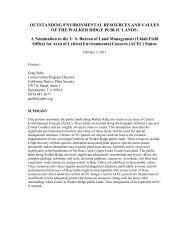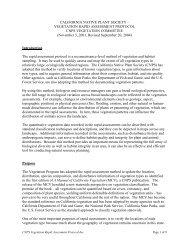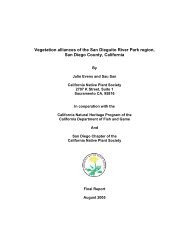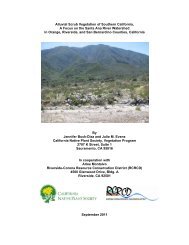CNPS comments Ft Irwin Supplemental Draft EIS - California Native ...
CNPS comments Ft Irwin Supplemental Draft EIS - California Native ...
CNPS comments Ft Irwin Supplemental Draft EIS - California Native ...
Create successful ePaper yourself
Turn your PDF publications into a flip-book with our unique Google optimized e-Paper software.
<strong>CNPS</strong> <strong>comments</strong> on <strong>Ft</strong>. <strong>Irwin</strong> SD<strong>EIS</strong>June 16, 2004Page 2 of 5than other current mitigation requirements. Additionally, the quality of habitat andspecific plant communities of the lands mitigation is unclear. The mitigation landsneed to be of similar quality habitat and have a ratio comparable to that of the type ofplant communities that are being impacted. No analysis of the available mitigationlands is provided.Some of the mitigation is based on the notion that newly acquired mitigation landswould be transferred to the Bureau of Land Management (BLM) for management asconserved lands to offset the destruction of fragile desert habitat during militarytraining on <strong>Ft</strong>. <strong>Irwin</strong>. The problem is that under the current draft prescriptions of theWest Mojave Plan, the BLM cannot retire grazing allotments in perpetuity forconservation purposes under the Taylor Grazing Act, cannot permanently withdrawlands from mining for conservation purposes under the 1872 mining law, and stillmust abide by their multiple use mandate. The <strong>CNPS</strong> fails to see how the transfer ofconservation lands to the BLM management will provide mitigation in the form ofpermanent conservation areas without significant modifications to the BLM’sregulations and other federal laws.While the Biological Assessment and the Addendum to Biological Assessment forthe Proposed Addition of Maneuver Training Land at Fort <strong>Irwin</strong> CA (24 February2004) provide a list of mitigation/conservation measures, all of the measures arebased “Within the limits of legislated funding”, which provides no assurances thatany of the mitigation/conservation commitments will be fulfilled. No guaranteedassurances equate to no guaranteed meaningful mitigations. No guaranteedmeaningful mitigations equate to guaranteed no project.The <strong>CNPS</strong> remains concerned as always that mitigation efforts will benefit somespecies (like the desert tortoise) more than others (like the plants). The Addendum toBiological Assessment for the Proposed Addition of Maneuver Training Land at Fort<strong>Irwin</strong> CA (24 February 2004) only states that “Representatives from Army, USFWS,BLM,and <strong>California</strong> Fish and Game will be invited to participate in a Working Groupto evaluate proposals to conserve the desert tortoise and Lane Mountain Milkvetch”.However, previous planning efforts in the desert have often focused on the deserttortoise to the detriment of conservation for rare plants. While the <strong>CNPS</strong> views thehabitat as an interconnected web of life, rare plants often have very specific habitatrequirements that cannot easily be duplicated or directly benefited by desert tortoiseconservation. The SD<strong>EIS</strong> and appendices do notNo education/training program for troop avoidance of sensitive biological resourcesis provided. The adequacy of this type of training materials needs to be presentedprior to its use as a mitigation measure, and therefore needs to be included as partof the SD<strong>EIS</strong>.Vegetation-Specific CommentsThe vegetation map provides important information on the regional plantcommunities that occur within the Preferred Alternative. However, those data arenot used to evaluate impacts to the plant communities. How much of whichcommunity type will be impacted by low, medium and high use? The significant
<strong>CNPS</strong> <strong>comments</strong> on <strong>Ft</strong>. <strong>Irwin</strong> SD<strong>EIS</strong>June 16, 2004Page 3 of 5impacts to vegetation communities stated in Table ES1.1-1 are not addressed in themitigation section 4.5.1.2.1 . In order to be in compliance with NEPA, the impactneed to be addressed by plant community and mitigated based on the impacts toeach plant community.The <strong>CNPS</strong> recognizes the Army’s contribution to increasing the knowledge base onthe locations and range of several sensitive plant species by funding field surveys.The impacts of the Preferred Alternative on the federally listed endangered LaneMountain Milkvetch (Astragalus jaegerianus) are of great concern to the <strong>CNPS</strong>. The<strong>CNPS</strong> does not concur with the Biological Opinion issued by the U.S. Department ofInterior – Fish and Wildlife Service that the Preferred Alternative as proposedguarantees not to jeopardize the existence of this endemic plant species. Thespecies is only known from an 18 square mile area on the planet, and the PreferredAlternative proposes eliminate over 3500 acres of occupied habitat and impact anunquantified additional amount of acreage. The <strong>CNPS</strong> concurs with the SD<strong>EIS</strong>’ thatthe Preferred Alternative will significantly impact the Lane Mountain Milkvetch. Thefollowing issues fail to conserve the Lane Mountain Milkvetch:• The two “conservation” areas located on Fort <strong>Irwin</strong> propose to conserve only48% of the habitat. Additionally, these “conservation” areas still allow nonmechanizedtraining to occur within them (Biological Opinion Pg. 10). Nonmechanizedtroop movement over the “conservation” area still has thepotential to directly impact the Lane Mountain Milkvetch and its habitat. Thisimpact has not been quantified or evaluated in the document. In fact, theimpacts from the allowed “clearing of sites and construction of roads” in theconservation areas are “an unquantified amount” according to the BiologicalOpinion (Page 50). This unquantified impact fails to meet the basicrequirements of NEPA, and brings into question how the Biological Opinionwas developed.• The “no-dig” zone in the Brinkman Wash – Montana Mine, which contains1,872 acres of Lane Mountain Milkvetch habitat will still allow for nonmechanizedtroop activity of low use. The “low use” areas reduce plant coverby up to 52% (SD<strong>EIS</strong>, Pg 4-12). These data indicate that the habitat in theBrinkman Wash – Montana Mine will also be reduced by 52% or 972 acres.The “no dig” is not clearly defined other than a conversion of the area to lowuse. No maps are included in the Addendum to Biological Assessment forthe Proposed Addition of Maneuver Training Land at Fort <strong>Irwin</strong> CA (24February 2004) that allow for an evaluation of the fragmentation of theimportant Brinkman Wash – Montana Mine population. This population is thelinkage population between the southwesterly Paradise Valley population andthe NTC-Gemini population. This population is important in providing geneticflow between populations. Fragmentation of habitat reduces fecundity (Baurand Erhardt 1995), and increase isolation of the populations and reducingfitness (Debinski and Holt 2000, Kruess and Tscharntke 1994). No analysesof these types of direct impacts are evaluated in the documents, even thoughthey are common issues pertaining to impacts. Therefore, this documentfails to fully evaluate and disclose the environmental impacts.
<strong>CNPS</strong> <strong>comments</strong> on <strong>Ft</strong>. <strong>Irwin</strong> SD<strong>EIS</strong>June 16, 2004Page 4 of 5• The Lane Mountain Milkvetch that are located on the Goldstone Deep SpaceCommunications Complex is not included in any conservation area (BiologicalOpinion Pg 53). Because it is part of the Nasa-Goldstone population and isdirectly adjacent to the “conservation” area, it needs to be included in the“conservation” area.• While the SD<strong>EIS</strong> and Appendices clearly indicate that the PreferredAlternative will significantly impact the Lane Mountain Milkvetch, themitigation offered outside of the two Fort <strong>Irwin</strong> “conservation” areas, isassisting the BLM in management of the Area of Critical EnvironmentalConcern (ACEC) on Coolgardie Mesa. The only assistance is acquiringsome private lands into federal ownership and closing and rehabilitatingillegal routes. The BLM has set aside this ACEC under the current <strong>Draft</strong>West Mojave Plan, and the <strong>CNPS</strong> supports this effort. However, we fail tosee how closing routes in the ACEC mitigates for the significant impact to thespecies caused by the Preferred Alternative. Closing routes in LaneMountain Milkvetch habitat outside of the expansion area is simplyinadequate to mitigate for the impacts from the Preferred Alternative.• If the Preferred Alternative is implemented, the notion of the recovery of theLane Mountain Milkvetch to levels which allow for its removal from ESAprotection is dashed because there will be no habitat left on which recoverycan occur that is not already occupied. The Preferred Alternative at bestrelegates the Lane Mountain Milkvetch to endangered status in perpetuity.This is one of the reasons why the <strong>CNPS</strong> does not concur with the BiologicalOpinion.• No opportunity for public involvement or appreciation of the Lane MountainMilkvetch on lands administered by the Department of Defense (DOD) isprovided. This is a public trust issue, not unlike sensitive archeologicalresources that are found on DOD lands. Controlled public access is given toview and enjoy these unique resources on other bases, and is appropriate forpublic access to the Lane Mountain Milkvetch.Desert Cymopterus (Cymopterus deserticola) is Mojave Desert endemic plant, and a<strong>CNPS</strong> 1B species. The Desert Cymopterus is regionally rare and has sustainedadditional human-caused impacts without the benefit of a regional conservationscenario. Therefore, the <strong>CNPS</strong> and the Center for Biological Diversity has petitionedUSFWS to provide protection for the Desert Cymopterus under the FederalEndangered Species Act. Currently, the USFWS has accepted the petition forreview and will be making a determination. The Preferred Alternative in the SD<strong>EIS</strong>will actually impact over 900 plants located within the expansion area (M. Quillman,personal communication, 5/6/04). Additionally, this same population represents asignificant range extension – the most northeasterly location ever documented.Species at the edge of their ranges are known to have important geneticcomponents (Addendum to the Hyundai Habitat Conservation Plan – USFWS 2004).The proposal to impact this important resource is a significant impact to the DesertCymopterus’ limited range, and must be mitigated. No mitigation is even proposedin the SD<strong>EIS</strong> for this species. The document fails to meet NEPA standards.
<strong>CNPS</strong> <strong>comments</strong> on <strong>Ft</strong>. <strong>Irwin</strong> SD<strong>EIS</strong>June 16, 2004Page 5 of 5Clokey’s cryptantha (Cryptantha clokeyi) is another Mojave Desert endemic plant,and a <strong>CNPS</strong> 1B species. The <strong>CNPS</strong> was delighted to hear of the record number ofplants identified by David Silverman. Our concern remains about the impact of thePreferred Alternative on the Clokey’s cryptantha and the lack of any type ofmitigation for it, other than protection to plant that occur within the Lane MountainMilkvetch “conservation” areas. No cumulative impacts to this species are evaluatedto their occurrences on NAWC.The <strong>CNPS</strong> submits these <strong>comments</strong> requesting that these issues be clearlyaddressed and that the impacts to the plant species and communities be adequatelymitigated if the Preferred Alternative is to be implemented. If you have anyquestions with regards to these issues please contact me at (323) 654-5943.Sincerely,Ileene AndersonSouthern <strong>California</strong> Regional Botanist<strong>California</strong> <strong>Native</strong> Plant Societycc:David Chipping, <strong>CNPS</strong> Conservation Director<strong>CNPS</strong> State OfficeUSFWSCDFG


